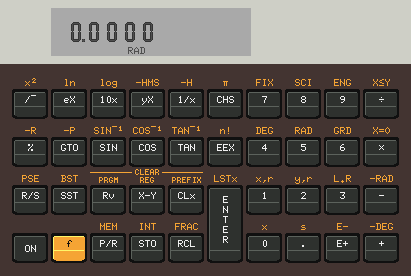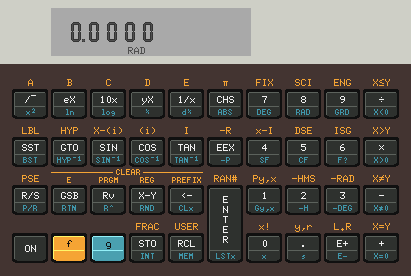Emulators for the HP 35, HP 80, HP 45, HP 70, HP 21, HP 22, HP25, HP 25C, HP 27, HP 29C, HP 31E, HP 32E, HP 33E, HP 33C, HP 34C, HP 37E, HP 38C, HP 38E, HP 67, HP 10C, HP 11C, HP 12C, HP 15C, and HP 16C.
All written in C using X11.
Use of any language extensions or non standard language features has been avoided in order to try to make the code as portable as possible.
The aim is to have the same source code compile without modification on Linux, VAX/VMS, and Tru64 Unix.
More screenshots
14 Apr 24
- Allows the size of the window to be adjusted using the
--zoom noption where n can be between 0 and 4. - Added an install option to the makefile (by default the installer will
use
$HOME/.localif it exists, but it is possible to specify another directory by setting the directoryprefix). - Embedded missing firmware.
24 Feb 24
-
By default the application will attempt to use the X11 base fonts. But if these are not available it will try to select an suitable alternate font instead from a predefined list.
For all the fonts to be rendered as intended users should ensure that the X11 base fonts are installed (see prerequisites).
16 Feb 24
- For UNIX based systems the default location used to store the state of
the machine when it is powered off has changed.
If the data file already exists in
$HOMEthen this will always be used by default, but if it does not exist then if$XDG_DATA_HOMEis defined the program will create a sub directory in this location for the data files or in or$HOME/.local/share/if$XDG_DATA_HOMEis not defined or does not exist. If$HOME/.local/share/does not exist then the program will use$HOMEas before.
01 Nov 23
- Updated DCL make script.
14 Oct 23
- Updated build instructions.
- Uses a simpler display on ARM (excluding Apple).
22 Sep 23
- Added ability to build using make on MacOS.
To build the simulator check that you have all the prerequisites installed then download the source code from github and unzip it (this will created a new directory automatically).
e.g:
$ wget https://github.com/mike632t/x11-calc/archive/refs/heads/stable.zip
$ unzip x11-calc-stable.zip
Then change directory to the new folder.
$ cd x11-calc-stable
The to compile all the emulators you just need to invoke make.
$ make clean; make all
It is also possible to compile a single emulator by specifying the model on the command line
$ make hp29c
By default the executable files will be created in the bin directory, and
can run either a particular emulator directly, or invoke the launcher which
will allow you to select which enulator to use by default the next time you
launch it.
$ ./bin/x11-calc-29c
x11-calc-29c: Version 0.10 [Commit ID: 399d546] 01 Nov 23 23:53:00 (Build: 0114)
ROM Size : 4096 words
OR
$ bin/x11-calc
If more than one C compiler is installed or if gcc is not available you can specify which one to use from the command line.
$ make CC=clang hp11c
$ make CC=tcc
On VMS unzip the source code archive, change the default directory and then
run make.com.
e.g:
$ unzip x11-calc-stable.zip
$ set def [.x11-calc-stable.src]
$ @make all
$ mc [-.bin]x11-calc-29c
x11-calc-29c: Version 0.10 [Commit ID: 399d546] 02 Nov 23 23:52:11 (Build: 0114)
ROM Size : 4096 words
On Linux systems after the compilation is complete you can use the makefile to install the emulator locally.
By default the installer will use $HOME/.local if it exists, but it is
possible to specify another directory by setting the directory prefix.
$ make install
OR
$ make install prefix=/usr
Installer also supports staged installs in a custom directory defined using DESTDIR.
make DESTDIR=/tmp/staging install
If you don't want to download an compile the sources your self the emulator is also available on Flathub and can be installed using Flatpak.
The emulators have been tested on the following systems:
-
Debian 12 (Bookworm), clang 14.0.6, x64 + arm64
-
Debian 12 (Bookworm), tcc 0.9.27, x64 + arm64
-
Debian 12 (Bookworm), gcc 12.2.0, x64 + arm64
-
Debian 11 (Bullseye), clang 11.0.1-2, x64
-
Debian 11 (Bullseye), gcc 10.2.1, x64
-
Debian 11 (Bullseye), tcc 0.9.27, x64
-
Debian 10 (Buster), gcc 8.3.0, x64 + arm
-
Debian 10 (Buster), clang 7.0.1, x64
-
Debian 9 (Stretch), gcc 6.3.0, arm
-
Debian 5 (Lenny), gcc 4.2.4, alpha
-
Fedora 34, gcc 11.2.1, x64
-
Fedora 35, gcc 11.3.1, x64
-
Fedora 35, clang 13.0.1, x64
-
Fedora 39, gcc 13.2.1, x64
-
Gentoo, gcc 11.2.0, x64
-
MacOS 10 (Catalina), clang 12.0.0, x64
-
MacOS 13.4.1 (Venture), clang 14.0.3, arm64
-
NetBSD 9.2, gcc 7.5.0, x64
-
SUSE 15.4, clang 13. 0.1, x64
-
SUSE 15.4, gcc 7.5.0, x64
-
Ubuntu 20.04, gcc 9.4.0, x64
-
Ubuntu 20.04, clang 10.0.0, x64
-
Ubuntu 20.04, tcc 0.9.27, x64
-
VAX/VMS 5.4-3, VAX C 3.2, VAX (simh)
-
OpenVMS 9.2-1, VSI C 7.4-726, x64
-
Windows 11 + WSL2, gcc 12.2.0, x64 + arm64
The following packages are required to build and/or run the simulator.
-
Debian : gcc | clang | tcc make libc6-dev libx11-dev xfonts-base
-
Fedora : gcc | clang make glibc-devel libX11-devel xorg-x11-fonts-base | xorg-x11-fonts-misc
-
Gentoo : gcc make libc6-dev libx11-dev font-misc-misc
-
MacOS : clang make xquartz
-
SUSE : gcc | clang make libX11-devel
-
Ubuntu : gcc make libc6-dev libx11-dev xfonts-base
-
Windows 11 + WSL2 : gcc make libc6-dev libx11-dev xfonts-base
The following keyboard shortcuts should work on Linux:
'0' - '9', '+'. '-'. '*'. '/' and 'Enter' should do what you expect them to (when using numeric key pad you need to use numlock as usual).
'f' and where applicable 'g' and 'h' correspond to the shift keys.
'Esc' or 'Backspace' corresponds to 'Clx', 'c' to CHS, 'e' to 'EEX', and on financial models 'n' and 'i' correspond to 'n' and 'i' if not shifted.
On programmable models 'A' - 'E' correspond to the function keys where they exist and 'Space' maps to 'SST' if not shifted.
'Ctrl-Z' Quits, and 'Ctrl-C' does a reset. For models with continuous memory 'Ctrl-Z' saves the current register contents, and 'Ctrl-C' restores them to the original saved state.
For models with continuous memory the contents of program memory and data registers are saved in a hidden file in the users' HOME directory when the program exits or the calculator is switched off, and restored from this hidden file when the simulator is loaded or reset using 'Ctrl-C'
~/.x11-calc-nn.dat
When starting the simulator the name of the data file used to restore the saved state can be specified on the command line allowing previously saved copies of programs to be loaded automatically when the simulator starts or the simulator is reset using 'Ctrl-C'. However, any changes will be saved in the hidden data file.
For models with a 'sliding' On/Off switch clicking on the switch will turn the simulator on or off, but if when switching off you hold down the switch down for two seconds the program will exit.
You can start the simulation in trace mode using '-t', or in single step mode using '-s', and set a breakpoint using '-b <octal address>'.
'Ctrl-T' also toggles trace mode when running, 'Ctrl-S' executes the next instruction, 'Ctrl-Q' resumes execution, and 'Ctrl-R' displays the contents of the CPU registers.
When in trace mode a jump to the same instruction produces no output.
The '-r ' command line option provides the ability to use the ROM contents from a separate file. The contents of the ROM are stored as pairs values seperated by a colon containing the memory address and the opcode.
Anything appearing after a semi colon on each line is ignored.
For the HP10C, HP11C, HP12C, HP15C and HP16C the ROM file contains pairs of hexadecimal values.
0000:107
0001:04e
0002:270
0003:238
0004:2ee
0005:13f
For other models the ROM file contains pairs of octal values.
00000:00255
00001:01420
00002:00451
00003:01456
00004:01746
00005:00472
When loading a ROM from file any gaps between the memory addresses will not be filled with zeros, and the existing ROM contents will be left unchanged.
ROM files can therefore be used to load alternative version of the firmware for a particular model or apply a patch to the existing firmware.
-
Keyboard shortcuts only work on Linux and NetBSD.
-
A 24 bit colour display is required.
-
For best results you need to have the X windows core fonts installed.
-
Parallel make only works on Linux.
Keyboard test is successful but these models do not pass the self-test.
- All 30 registers have continuous memory.
- Fails self test.
- Cannot read or write to magnetic cards.
- Has continuous memory.
- The code uses a simplified display on Arm based systems (except Apple) to avoid the display refresh issues seen on the Raspberry Pi if either FKMS or KMS overlays are enabled. (Note- Do not disable KMS on the latest Raspberry Pi OS release).
- Performance under Xwayland is generally poor, the emulator will work well on a Raspberry Pi3 using Xwindows but a Raspberry Pi4 using Xwayland cannot redraw the display quickly enough to allow background shading to be used to draw the display digits. As a result the emulator's LED/LCD display doesn't use any background shading on ARM based systems.
- The emulator window is supposed to be a fixed size. However wnen running on Xwayland the window manager does not handle this correctly.
- Colour palette assumes a black and white display.
- Not all text is visible due to the limited colour palette and the DEC fonts are missing some characters (for example the Pi symbol).
If you find problems or have suggestions relating to these simulators, then please create a new issue.
Your problem report should contain:
-
Architecture (and VM host if applicable);
-
Operating System and version;
-
Desktop Environment and version;
-
Window Manager and version;
-
Compiler and version used;
-
Commit ID;
-
A description of the problem.
Thank you.

